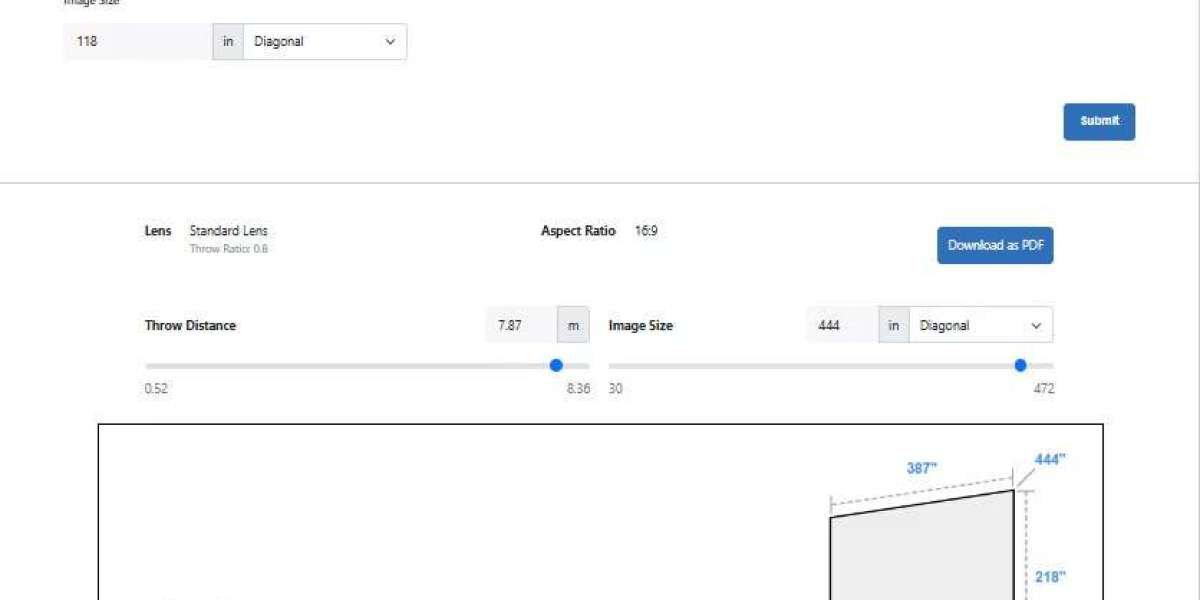Choosing the right projector is a critical step in creating a high-quality home theater or professional AV setup. One of the most important factors to consider is the distance between the projector and the screen, commonly defined by the Throw Ratio. XTEN-AV, a leader in AV system design, offers tools and simulations that help you determine the ideal projector type for your space. In this blog, we will explore the differences between short throw and long throw projectors, their advantages, limitations, and how to choose the one that best fits your needs.
1. Understanding Throw Ratio
Throw ratio is a key specification that determines how far a projector needs to be from the screen to produce a certain image size. It is calculated as the distance from the projector to the screen divided by the width of the projected image.
A short throw projector has a throw ratio typically less than 1.0, allowing it to project a large image from a short distance.
A long throw projector has a throw ratio greater than 1.5, requiring more distance to achieve the same image size.
Knowing the throw ratio helps you choose a projector that fits your room dimensions and desired screen size, ensuring optimal image quality and placement flexibility.
2. Short Throw Projectors
Short throw projectors are designed to be placed close to the screen, often just a few feet away. They are particularly popular in small rooms, apartments, and spaces with limited depth.
Advantages
Space Efficiency: Ideal for small rooms where placing a projector far from the screen is not possible.
Reduced Shadows: Since the projector is close to the screen, people walking in front of it are less likely to cast shadows.
Versatility: Can be mounted on a shelf, table, or very close to the wall.
Limitations
Price: Short throw projectors tend to be more expensive than standard long throw models.
Image Distortion: Some models may have slight distortion at the edges, requiring lens shift or keystone correction.
Brightness: In larger rooms, short throw projectors may struggle to provide sufficient lumens for a bright image.
Short throw projectors are perfect for apartments, bedrooms, or small living rooms where space is at a premium. XTEN-AV can simulate the placement and screen alignment to create a Perfect Projector Layout in compact spaces.
3. Long Throw Projectors
Long throw projectors are designed for larger rooms and auditoriums where the projector can be positioned farther from the screen. They are commonly used in home theaters, conference rooms, and large venues.
Advantages
Image Size: Capable of projecting larger images with high resolution and brightness.
Flexibility: Suitable for professional AV setups and rooms with fixed projector mounts.
Brightness: Typically higher lumen output, making them effective in rooms with ambient light.
Limitations
Space Requirements: Requires a longer distance from the screen, which may not be feasible in small rooms.
Shadows: People moving in front of the projector beam can cast shadows on the screen.
Installation Complexity: Ceiling mounts or extended cabling may be needed, increasing setup difficulty.
Long throw projectors are ideal for home theaters, living rooms with sufficient depth, or professional installations where a large image is required.
4. Comparing Short Throw and Long Throw Projectors
| Feature | Short Throw Projector | Long Throw Projector |
|---|---|---|
| Throw Ratio | Less than 1.0 | Greater than 1.5 |
| Placement Distance | Very close to screen | Far from screen |
| Space Requirement | Small rooms | Large rooms |
| Brightness | Moderate | High |
| Shadow Issues | Minimal | Potential |
| Cost | Higher | Lower for similar resolution |
| Installation Flexibility | Flexible mounting options | Requires more planning |
This comparison helps you identify which projector type aligns with your room size, layout, and viewing preferences.
5. Factors to Consider When Choosing
When deciding between short throw and long throw projectors, consider the following:
Room Size: Measure the distance between the screen and potential projector locations. Use the throw ratio to calculate image size.
Screen Size: Determine your desired image size and ensure the projector can achieve it from the available distance.
Ambient Light: If the room has natural light or multiple light sources, long throw projectors with higher lumens may perform better.
Mounting Options: Consider ceiling, wall, or table placement, and how it affects projector alignment and cable routing.
Budget: Short throw projectors often cost more but provide flexibility in small spaces. Long throw projectors are more cost-effective for larger rooms.
Content Type: Movies, gaming, and presentations may have different brightness and resolution requirements.
XTEN-AV helps you visualize these variables, allowing precise placement, height adjustments, and alignment to ensure a Perfect Projector Layout.
6. Using a Throw Ratio Calculator
A throw ratio calculator simplifies the decision-making process:
Input your room dimensions and screen width.
Specify the projector type to calculate optimal distance.
Adjust variables like lens shift, ceiling height, and screen angle for accuracy.
This tool ensures you select the right projector type and placement, reducing trial and error during installation.
7. Practical Tips for Both Types of Projectors
Regardless of your choice:
Calibrate Image: Adjust brightness, contrast, and color settings for optimal viewing.
Position Speakers: Ensure audio aligns with the projected image for an immersive experience.
Manage Cables: Use conduits or cable sleeves to prevent clutter.
Test Content: Preview movies or presentations to confirm image size, clarity, and alignment.
Proper planning maximizes the performance of your projector, whether short throw or long throw.
Conclusion
Choosing between a short throw and long throw projector depends on your room size, desired image size, ambient light, and budget. Short throw projectors are ideal for compact spaces where placement flexibility is crucial, while long throw projectors excel in large rooms where image size and brightness are priorities. Understanding the Throw Ratio and planning the layout with tools like XTEN-AV ensures a Perfect Projector Layout tailored to your space.
By carefully evaluating your room, projector type, and installation requirements, you can achieve a cinematic experience that maximizes both visual impact and comfort, transforming any space into an immersive home theater.
Read more: https://avfusionhorizon.weebly.com/blog/what-is-throw-ratio-and-why-it-matters














